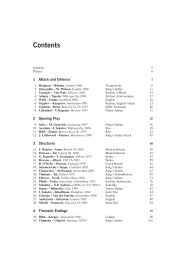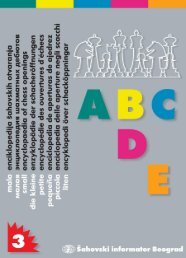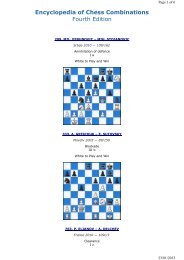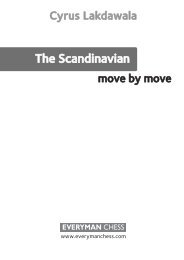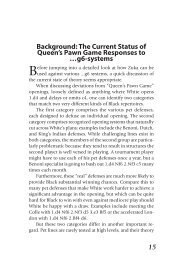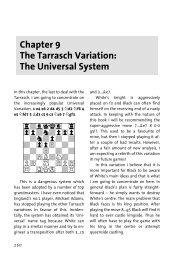Introduction to Dutch Defense Material - Zuka
Introduction to Dutch Defense Material - Zuka
Introduction to Dutch Defense Material - Zuka
You also want an ePaper? Increase the reach of your titles
YUMPU automatically turns print PDFs into web optimized ePapers that Google loves.
Chapter 11<br />
2. Developing the Bishop in this way is inconsistent with<br />
White’s desire <strong>to</strong> fianchet<strong>to</strong> his other Bishop.<br />
3. Black’s thematic …e5 comes with tempo and practically<br />
guarantees equality.<br />
Hold on a sec. Why is Bf4 “inconsistent” with fianchet<strong>to</strong>ing<br />
the light-squared Bishop?<br />
If Black plays …d6 and White plays g3, there is not much<br />
breathing room for a dark-squared Bishop on that wing.<br />
Anyway, I contend these concerns lose significant potency<br />
if White castles long, or at least retains the ability <strong>to</strong> do so.<br />
White then welcomes the expansion of Black’s K-side pawns,<br />
so the first point listed above is hardly a concern. It will, in<br />
fact, seldom even be a reasonable plan <strong>to</strong> consider. Similarly,<br />
the value attached <strong>to</strong> playing Bg2 depends on the assumption<br />
that White castles short. In typical play, White attacks on the<br />
Q‐side while Black presses on the K-side. A Bishop on g2 helps<br />
defend White’s King and also hinders Black’s Q-side development,<br />
particularly in that Black has trouble safely playing<br />
…Bb7. In our reper<strong>to</strong>ire, however, lines with a Bishop on b7<br />
are not particularly troublesome, especially as they leave e6,<br />
f5, and g4 with less protection.<br />
With regard <strong>to</strong> the third point, Black has by no means<br />
solved all his problems once he plays …e5. Indeed, the pawns<br />
on e5 and f5 are high-maintenance and can be real liabilities if<br />
White castles long. To see an example of this, consider a typical<br />
position suggested by Pinski (via transposition) after:<br />
1.d4 f5 2.Bf4 e6 3.Nf3 Nf6 4.e3 d6 5.c4 Be7 6.Nc3 0-0 7.Qc2<br />
Qe8 8.h3 Nc6 9.a3 Bd8 10.0-0-0<br />
214



